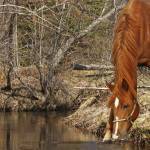Nitrate and Nitrite Toxicity in Horses

Nitrate toxicity is uncommon in horses but can be an important problem in ruminants. Horses can be exposed to nitrates by eating fertilizer or toxic forages and drinking contaminated water. Ruminants are much more susceptible to nitrate toxicity because nitrate (NO3-) is chemically reduced in the rumen to the much more toxic nitrite (NO2-). Horses are relatively resistant to nitrate toxicity because they are hindgut fermenters and do not have a rumen.
In the large intestine of the horse, only about 25% of nitrate is converted to nitrite. In the few reported cases of nitrate poisoning in horses, the most common sources were contaminated ground water, direct ingestion of fertilizer, or consumption of forage grown in the area of spilled fertilizer. Some weeds (Johnsongrass, pigweed, jimsonweed, fireweed, lambsquarters) and vegetables accumulate nitrate, and other plants can also have increased nitrates whenever they are stressed by cloudiness, drought, or freeze. Bacteria can produce nitrite from nitrate in hay if the forage is high in nitrates and baled when wet.
Clinical signs of nitrate/nitrite poisoning include colic, diarrhea, respiratory difficulty, weakness, muscle tremors, abnormal gait, shaking, elevated heart rate, seizures, blue to brown discoloration of the gums, and death. Nitrite is absorbed into the blood, where it damages hemoglobin, the iron pigment in red blood cells that allows them to carry oxygen, and converts it to methemoglobin, which cannot carry oxygen. Blood in affected animals might be chocolate brown instead of deep red.
Fertilizer should be used only as recommended by the manufacturer and the pasture should be rested for at least as long as directed on the fertilizer label. It is important to read the label and plan in advance how to manage grazing horses and fertilized pastures. Fertilizer spills should be prevented in grazing areas, and fertilizer should not be hauled in water tanks. Hay should not be baled or fed when wet to avoid bacterial production of nitrite. Colleges of agriculture, diagnostic laboratories, or extension agents can direct producers to laboratories that test feedstuffs and water sources for nitrates.
Much more is known and reported for nitrate/nitrite toxicity in cattle than horses. In cattle, nitrate levels less than 0.44% of dry matter (up to 4400 ppm) can usually be fed safely.
Horses are likely to tolerate significantly higher concentrations of nitrates (at least up to 2%) in forages. If nitrate toxicity is suspected, consult your veterinarian, look for clinical signs in any ruminant animals being fed with horses, and submit water and forage samples for measurement of nitrate concentrations.








